

Polynesians steering by the stars met Native Americans long before Europeans arrived. By about 1200 C.E., Polynesians were masters of oceanic exploration, roaming 7000 kilometers across the Pacific Ocean in outrigger canoes.
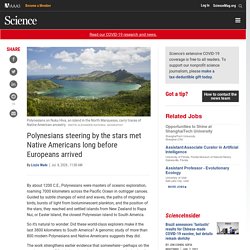
Guided by subtle changes of wind and waves, the paths of migrating birds, bursts of light from bioluminescent plankton, and the position of the stars, they reached and settled islands from New Zealand to Rapa Nui, or Easter Island, the closest Polynesian island to South America. So it’s natural to wonder: Did these world-class explorers make it the last 3800 kilometers to South America? Oceania/Pacific.
Papua New Guinea. Australia. Study: Native Australians may be oldest living civilization outside of Africa. Humanity was born in Africa.
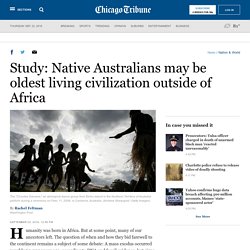
But at some point, many of our ancestors left. The question of when and how they bid farewell to the continent remains a subject of some debate: A mass exodus occurred roughly 60,000 years ago, according to DNA and fossil evidence, but signs point to some back-and-forth migration much earlier than then. In a trio of studies published Wednesday in Nature, researchers attempt to trace the origin of our species by looking to neglected DNA - populations that haven't been studied as extensively as large European and Asian ethnic groups.
Together, the studies present 787 high-quality genomes from people around the world. Lost and Found in Borneo’s Jungle: A Tragic Tale of Two Men in Sarawak. One man was a Swiss environmental activist who wore a loincloth and learned to hunt with a blowpipe before mysteriously disappearing in Sarawak.

The other was an art dealer from California who swapped surfing for a life of adventure, travelling deep into the jungles of Borneo in search of the fabulous art of the Dayak people. In his new book, The Last Wild Men Of Borneo, author Carl Hoffman brings together the stories of Bruno Manser and Michael Palmieri, two very different, yet similar, men, and their obsession with one of the wildest places on Earth. The Terrible Emotion Locked In A Word click 2x. Anthropologists Renato and Shelly Rosaldo lived in the Philippines with the Ilongot, an isolated tribe in the rain forest.
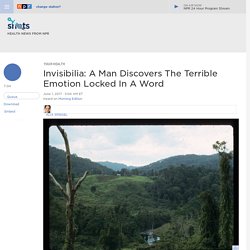
They were based here, in a settlement of Kakidugen, from 1967 to 1969 and in 1974. Courtesy of Renato Rosaldo hide caption toggle caption. Evidence of Unknown Human Species Found in DNA of Melanesians. Scientists found traces of a previously unknown, long-extinct human species hidden in the DNA of today’s Melanesians.
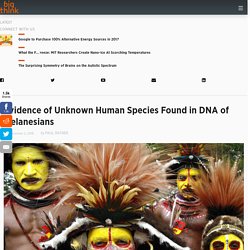
Melanesia is an area in the South Pacific Ocean to the northeast of Australia that includes the countries of Vanuatu, the Solomon Islands, Fiji, and Papua New Guinea as well as some islands belonging to other nations. The two ancient hominid species whose DNA traces scientists expected to find were the Neanderthals and Denisovians. But the results of the study showed something else. "We’re missing a population, or we’re misunderstanding something about the relationships," said Ryan Bohlender, a statistical geneticist from the University of Texas to Science News. The goal for the researchers was to investigate how much ancient DNA we carry today. Map of Oceania. The $100bn gold mine and the West Papuans who say they are counting the cost. In 1936, Dutch geologist Jean Jacques Dozy climbed the world’s highest island peak: the forbidding Mount Carstensz, a snow-covered silver crag on what was then known as Dutch New Guinea.
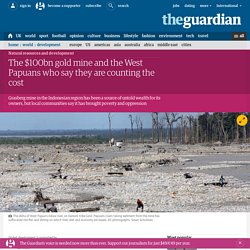
During the 4,800-metre ascent, Dozy noticed an unusual rock outcrop veined with green streaks. Samples he brought back confirmed exceptionally rich gold and copper deposits. How We Got Here: DNA Points to a Single Migration From Africa. Each team of researchers tackled different questions about our origins, such as how people spread across Africa and how others populated Australia.
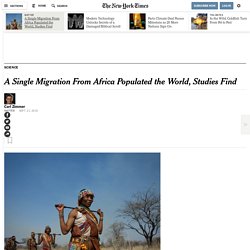
But all aimed to settle the controversial question of human expansion from Africa. In the 1980s, a group of paleoanthropologists and geneticists began championing a hypothesis that modern humans emerged only once from Africa, roughly 50,000 years ago. Skeletons and tools discovered at archaeological sites clearly indicated that modern humans lived after that time in Europe, Asia and Australia. Early studies of bits of DNA also supported this idea. All non-Africans are closely related to one another, geneticists found, and they all branch from a family tree rooted in Africa.
Yet there are also clues that at least some modern humans may have departed Africa well before 50,000 years ago, perhaps part of an earlier wave of migration. Dr. Intrigued, Dr. Photo Despite earlier research, the teams led by Dr. Cyclone Pam devastates Pacific islands of Vanuatu. Vanuatu's President Makes a Leap in Tying Cyclone Pam to Climate Change. Action Against Climate Change: Coastal erosion in Vanuatu. 'Pacific Climate Warriors' blockade Newcastle harbour – in pictures.
HOW TO LET GO OF THE WORLD AND LOVE ALL THE THINGS CLIMATE CAN'T CHANGE trailer. ABC Online Indigenous - Interactive Map. PNG- Kalam 2 clicks. Culture and peoples of the Insular Pacific region. First Footprints. 8ways - home. Aboriginal dancer Djoli Laiwanga performs at a festival in Papua New Guinea. Friend or foe? Anthropology’s encounter with Aborigines. An Aboriginal colleague recalls: “When I started at university you would say ‘anthropologist’ and spit on the ground in disgust.
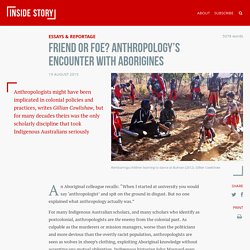
But no one explained what anthropology actually was.” For many Indigenous Australian scholars, and many scholars who identify as postcolonial, anthropologists are the enemy from the colonial past. As culpable as the murderers or mission managers, worse than the politicians and more devious than the overtly racist population, anthropologists are seen as wolves in sheep’s clothing, exploiting Aboriginal knowledge without accepting any mutual obligation. CAD Wiki: Maori Learning and Teaching Hub. Kia ora koutou Welcome to the Māori Learning and Teaching hub.
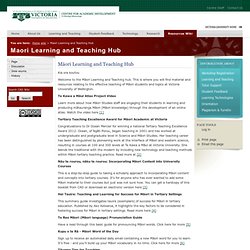
This is where you will find material and resources relating to the effective teaching of Māori students and topics at Victoria University of Wellington. Te Kawa a Māui Atlas Project Video Learn more about how Māori Studies staff are engaging their students in learning and producing mātauranga Māori (Māori knowledge) through the development of an online atlas. Aboriginal Perspectives Resources (with thanks to Anita Heiss) « LisaHillSchoolStuff's Weblog. As teachers know, the new Australian Curriculum includes three cross-curriculum ‘priorities’, one of which is Aboriginal and Torres Strait Islander histories and cultures.
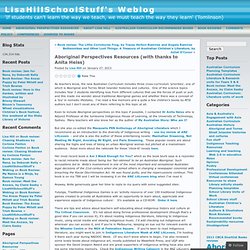
One of the science topics includes Year 2 students identifying toys from different cultures that use the forces of push or pull, and this made me wonder about traditional Aboriginal games and whether there was a concept of a ‘toy’ in nomadic lifestyles. I’ve read a few memoirs and a quite a few children’s books by ATSI authors but I don’t recall any of them referring to this topic at all. Keen to include Aboriginal perspectives on this topic if possible, I contacted Dr Anita Heiss who is Adjunct Professor at the Jumbunna Indigenous House of Learning, at the University of Technology, Sydney.